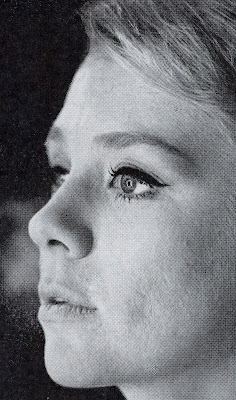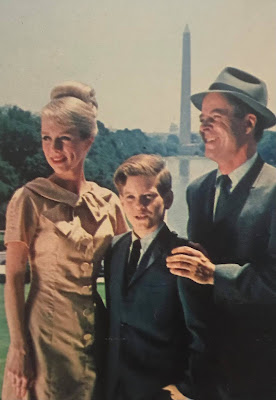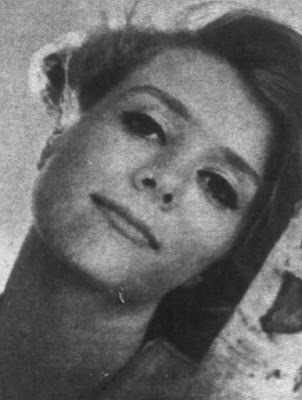 |
George and Inger during the filming of the
1961 Route 66 episode "Burning for Burning". |
When asked about the great actors and actresses he worked with in the past, actor George Maharis listed Inger first. In 2021, Maharis told Rock Goldschmidt of ReMIND Magazine, “I got to work with some wonderful actors and actresses including Inger Stevens, Boris Karloff and Buster Keaton."
George, who recently died at the age of 94 on May 24th, became close friends with Inger after she guest starred in "The Beryllium Eater" episode of Route 66 in 1960. I cannot help but think that Inger would have lived much longer had she possessed more friends as true as George during her lifetime.
George told Inger's biographer William Patterson:
I liked her humanness and warmth. But, at first, she seemed almost afraid of me. Knowing I was a bachelor, she thought that I might be on the make, eager to make a conquest rather than a friend.
George was attracted to Inger's "stubby nose, a crooked mouth, freckles, and listening eyes." Three years after their first episode together (the second would be 1961's "Burning for Burning"), George described Inger as "a marvelous woman, really" and added:
I like Inger. She has a heart as big as the world. I've always had the feeling she needs me. She's the kind of girl who haunts you. You get up in the morning thinking of her and how sweet she is. You want to do things for her. It's a great feeling. Inger and I never went out to fancy places, we just sat around and talked. She's the kind of girl who listens with her big, blue eyes. She gives me the feeling that's she's a sort of trusting child to whom you can say, 'I have four legs,' and she'd believe you.
 |
George and Inger in the 1960
Route 66 episode "The Beryllium Eater". |
After filming "Burning for Burning" in 1961, Inger and George didn't work together again until 1970, but the two remained good friends due to their mutual respect for and understanding of each other. In 1964, George and Inger attended Young Citizens for President Johnson' barbecue party for Luci Baines Johnson in Beverly Hills, California. The photos below show them speaking with Steve McQueen.
George and Inger had many traits in common. As George said after Inger's death in 1970, a major shared characteristic was "falling in love with the wrong people...it's usually harder on a woman, though."
Both lived without regrets. In 1970, George said:
Everything I do is on the spur of the moment. I've made a lot of rash decisions and mistakes in my lifetime. But I don't regret any of them for one minute. I've never lost any sleep over them. My creed is, do what you think is right, do the best you can, and the heck with it.
Years earlier, Inger shared a similar philosophy:
I hate the word mistakes...I regard life as a series of steps. Maybe I've stumbled on some of those steps. Lots of young people do. But I don't regret it. Everything that has happened to me has helped make me the person I am.
Although both Inger and George valued the artistic rewards of acting, neither were smitten with the business itself. George stated:
I'm only interested in artistic endeavors. The rest you can have. I don't care about business. I don't want to be a millionaire. I tell my manager just to put the money working so people won't tread on me and I won't be a nuisance to other people or to the state when I get old, if I do.
Inger talked about the business of Hollywood, too, sharing:
I was afraid of the people who were handling me at the time. They gave me so much advice contrary to my own ideas...The more I tried to follow their advice, the less inner peace I found.
This town has a tendency to swallow you up...Sometimes people here do everything for the mythical career. Some people sacrifice everything to get on top of the heap. They sacrifice friendship, their own individuality, and become a slave to a career.
Like George, Inger, in 1969, insisted she would never be a nuisance to others. She said:
They'll never hold a benefit for me. And the only reason I'll ever go to the motion picture country home is to entertain the old timers out there.
To maintain privacy surrounding their individual romantic lives, George and Inger cited their busy work schedules on popular television shows.
George answered why he hadn't settled down by stating:
This TV series has given me countless opportunities for that sort of thing but the heavy work schedule, the constant moving around have prevented me from doing very much about it.
Though she was already married to Ike Jones at the time, Inger responded:
Yes, I want to get married, but it will take a very special understanding man to put up with my schedule. I have to be up at 5 a.m. to leave for the studio, and I usually don't get home until 8:20 at night. I never have a day off in the series, and when I do, I have to shoot commercials or photographs.
If they found themselves hemmed in by their public images, Inger and George turned to painting as an outlet of free expression.
Inger commented:
I like to paint for relaxation. I think the reason that actors and actresses paint is that it's the one thing that they can do that other people really don't tamper with.
George echoed this sentiment in 2021:
I have always loved painting, as you are free to do what you want to do. Just me, the paint and the canvas!
In 1970, after starring in Aaron Spelling's television movie Run, Simon, Run, Inger signed on to costar with George Maharis and Ralph Bellamy in the forensic crime drama Zig Zag (soon renamed The Most Deadly Game). Inger and George worked together preparing promotional videos of the show in the months leading up to her death.
George recalled learning of Inger's death:
I heard about it at home. Aaron Spelling phoned me. Inger had appeared to be in good spirits, in good health. We had had several conferences on the series. We had just made some promotional films together. It was a great shock...Inger was a personal friend of mine. I loved her and the idea of working with her. We both liked all the elements. It was going to be a great combination.
After Inger's death, the female lead in The Most Deadly Game was played by Yvette Mimieux and the show did not last its first season. Though we were robbed of watching Inger and George costar once more, the promotional video still exists.
 |
| Zig Zag (1970) |
 |
| Zig Zag (1970) |
 |
| Zig Zag (1970) |
Thank you, Mr. Maharis, for the indelible mark you left in the world of television and movies. Thank you for enhancing the soundtrack of the 1960's with your smooth, swinging recordings. Thank you most of all for treating our Inger with the kindness and respect she deserved from all of her peers and for continuing to speak her name and share her talents until the end of your life.
Sources:
Boston Globe. October 4, 1970.
Cincinatti Enquirer. October 23, 1970.
Daily News. December 18, 1960.
Miami Herald. August 26, 1962.
Orlando Evening Star. July 3, 1970.
Photoplay. January 1962.
San Francisco Examiner. July 26, 1970.
















































